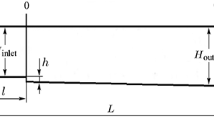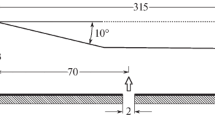Abstract
A functional mathematical model of a hydrogen-driven combustion chamber for a scramjet is described. The model is constructed with the use of one-dimensional steady gas-dynamic equations and parametrization of the channel configuration and the governing parameters (fuel injection into the flow, fuel burnout along the channel, dissipation of kinetic energy, removal of some part of energy generated by gases for modeling cooling of channel walls by the fuel) with allowance for real thermophysical properties of the gases. Through parametric calculations, it is found that fuel injection in three cross sections of the channel consisting of segments with weak and strong expansion ensures a supersonic velocity of combustion products in the range of free-stream Mach numbers M∞ = 6–12. It is demonstrated that the angle between the velocity vectors of the gaseous hydrogen flow and the main gas flow can be fairly large in the case of distributed injection of the fuel. This allows effective control of the mixing process. It is proposed to use the exergy of combustion products as a criterion of the efficiency of heat supply in the combustion chamber. Based on the calculated values of exergy, the critical free-stream Mach number that still allows scramjet operation is estimated.
Similar content being viewed by others
References
E. S. Shchetinkov, “Method of Ramjet Operation,” USSR Patent No. 471815 SSSR, MPK F 02 K 7/10, Published April 16, 1957.
A. Ferri, “Review of SCRAMJET Propulsion Technology,” J. Aircraft 5 (1), 3–10 (1968).
F. Chalot, P. Rostand, P. Perrier, et al., “Validation of Global Aero Propulsive Characteristics of Integrated Configurations,” AIAA Paper No. 98–1624 (1998).
S. I. Baranovskii, A. S. Nadvorskii, and A. I. Turishchev, “A Two-Dimensional Model of the Combustion of Hydrocarbon Fuels in Supersonic Flow,” Fiz. Goreniya Vzryva 28 (4), 32–36 (1992) [Combust., Expl., Shock Waves 28 (4), 347–350 (1992)].
A. F. Latypov, “Exergy Analysis of Ramjet,” Teplofiz. Aeromekh. 16 (2), 319–330 (2009) [Thermophys. Aeromech. 16 (2), 303–314 (2009)].
A. F. Latypov, “Condition of Existence of a Steady Flow in a Variable-Section Channel with Heat Supply and Kinetic Energy Dissipation,” Pis’ma Zh. Tekh. Fiz. 38 (22), 21–27 (2012).
J. Warnatz, U. Maas, and R. W. Dibble, Combustion. Physical and Chemical Fundamentals, Modeling and Simulations, Experiments, Pollutant Formation (Springer, 2001).
C. G. Rodriguez, J. A. White, and D. W. Riggins, “Three-Dimensional Effects in Models of Dual-Mode Scramjets,” AIAA Paper No. 2000-3704 (2000).
R. C. Rogers, D. P. Capriotti, and R. W. Guy, “Experimental Supersonic Combustion Research at NASA Langley,” AIAA Paper No. 98-2506 (1998).
V. K. Baev and V. V. Shumskii, “Effect of Gasdynamics of a Two-Regime Combustor on the Power Characteristics of a Model with Combustion,” Fiz. Goreniya Vzryva 31 (6), 49–63 (1995) [Combust., Expl., Shock Waves 31 (6), 661–670 (1995)].
E. S. Shchetinkov, Physics of Combustion and Explosion (Nauka, Moscow, 1965) [in Russian].
A. F. Latypov and O. V. Popik, “Numerical Method of Solving the Cauchy Problem for Stiff Ordinary Differential Equations on the Basis of Multielement Interpolation Hermite Polynomials,” Vychisl. Tekhnol. 16 (2), 78–85 (2011).
A. P. Vasil’ev, V. M. Kudryavtsev, V. A. Kuznetsov, et al., Fundamentals of the Theory and Calculation of Liquid-Propellant Rocket Engines (Vysshaya Shkola, Moscow, 1967) [in Russian].
B. A. Uryukov, “Theory of the Differential Ejector,” Prikl. Mekh. Tekh. Fiz., No. 5, 41–47 (1963).
A. F. Latypov, “Exergy Method for Estimating the Ramjet Specific Impulse,” Teplofiz. Aeromekh. 20 (5), 547–560 (2013) [Thermophys. Aeromech. 20 (5), 539–554 (2013)].
Author information
Authors and Affiliations
Corresponding author
Additional information
Original Russian Text © A.F. Latypov.
Translated from Prikladnaya Mekhanika i Tekhnicheskaya Fizika, Vol. 56, No. 5, pp. 76–90, September–October, 2015.
Rights and permissions
About this article
Cite this article
Latypov, A.F. Functional mathematical model of a hydrogen-driven combustion chamber for a scramjet. J Appl Mech Tech Phy 56, 799–812 (2015). https://doi.org/10.1134/S0021894415050065
Received:
Revised:
Published:
Issue Date:
DOI: https://doi.org/10.1134/S0021894415050065




